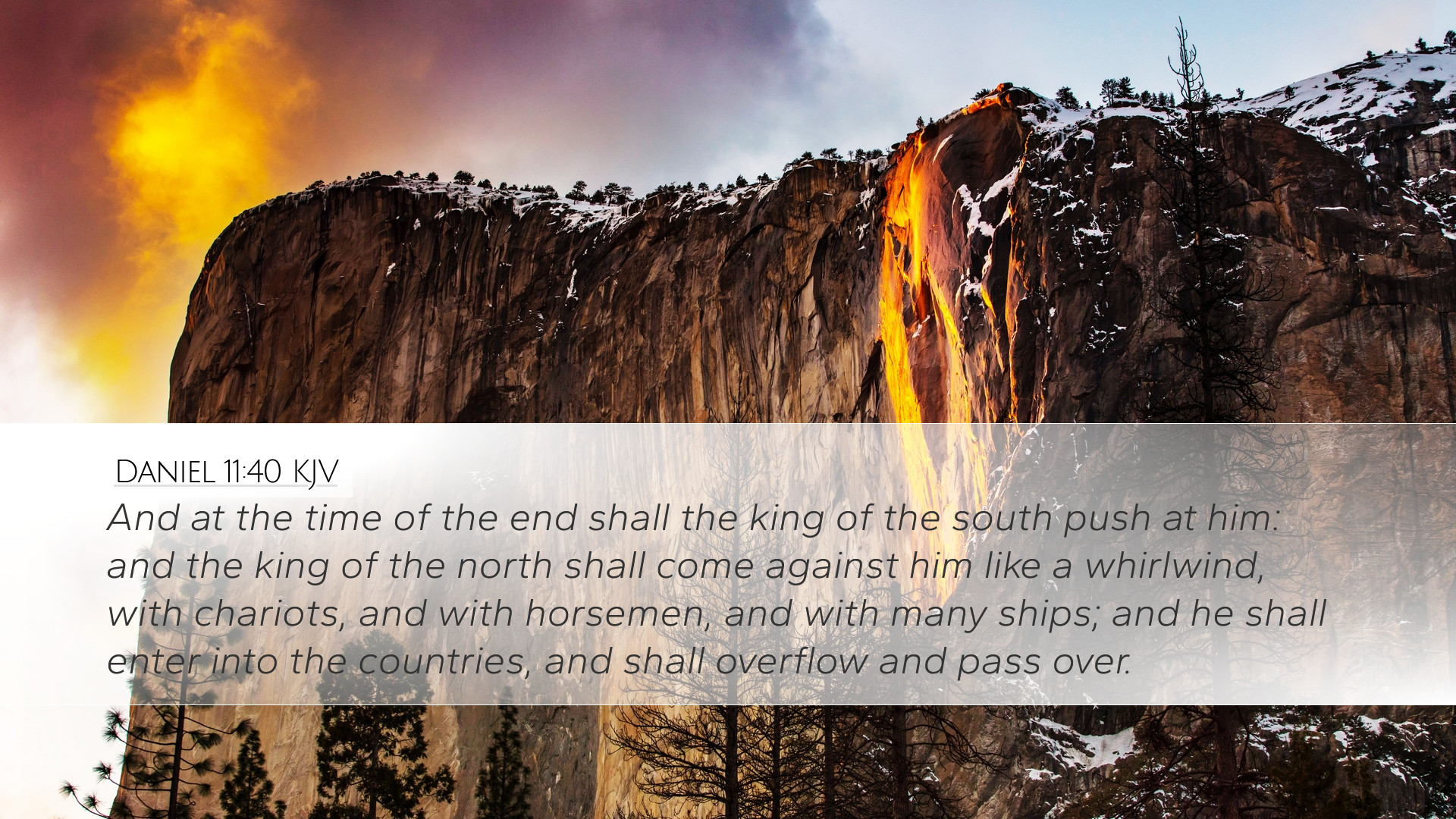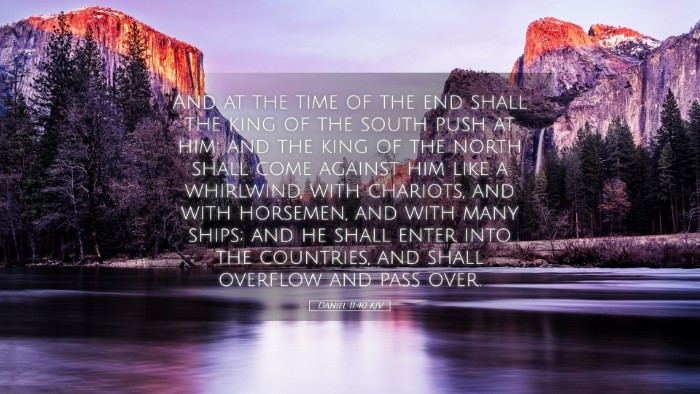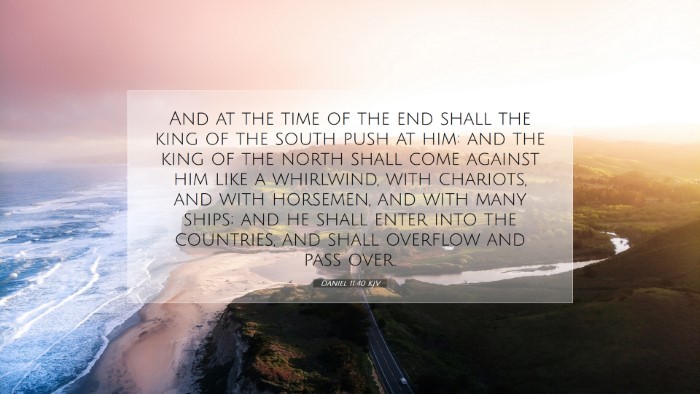Commentary on Daniel 11:40
Verse: Daniel 11:40 - "At the time of the end shall the king of the south push at him: and the king of the north shall come against him like a whirlwind, with chariots, and with horsemen, and with many ships; and he shall enter into the countries, and shall overflow and pass over."
Introduction
This verse marks a pivotal moment in the apocalyptic vision given to Daniel. It encapsulates a prophetic conflict involving the “king of the south” and the “king of the north,” as part of the broader narrative of the last days. The interpretations of this passage have varied, reflecting different historical, theological, and eschatological frameworks. This commentary synthesizes insights from prominent public domain scholars, enriching the understanding of the verse for pastors, students, theologians, and Bible scholars.
Historical Context
Daniel 11 outlines the succession of empires and conflicts that shape Israel's history. The mention of the “king of the south” and the “king of the north” reflects the geopolitical tensions following the fragmentation of Alexander the Great's empire. Scholars like Albert Barnes point to the Ptolemaic and Seleucid dynasties, emphasizing their roles in the unfolding drama of the Old Testament narrative.
Matthew Henry elaborates that this conflict symbolizes the ongoing spiritual battles, where earthly powers serve as vessels for deeper, spiritual realities, culminating in the eschatological framework.
Interpretations of the Kings
- King of the South: Traditionally identified with Egypt, represented predominantly by the Ptolemaic dynasty. This nation is characterized by its attempts to assert dominance over the territories influenced by the north.
- King of the North: Often associated with the Seleucid Empire, stretching from the region encompassing Syria and parts of Asia Minor. Barnes describes it as representing the power and aggression characteristic of this empire.
Understanding these identifiers is crucial for a nuanced interpretation of the ensuing conflict portrayed in the prophetic vision.
The Nature of the Conflict
In verse 40, the conflict is described vividly: "the king of the south push at him" suggests an aggressive approach, indicative of the south's desperation to reclaim power. Conversely, the response from "the king of the north," depicted as coming "like a whirlwind," indicates overwhelming force and swiftness in response. Adam Clarke highlights that this whirlwind imagery speaks to the intensity of divine judgment utilized through historical leaders and armies as instruments of God’s purpose.
Symbolism and Prophetic Elements
The terminology employed in this scripture carries significant weight. The "chariots," "horsemen," and "many ships" symbolize the might of the forces involved, indicating that the conflict is not limited to terrestrial powers but has a divine dimension. Matthew Henry emphasizes that the use of "many ships" implies a far-reaching influence, demonstrating the world's interconnectedness in the eschatological scenario.
Eschatological Perspectives
Pastors and theologians often emphasize the relevance of this prophecy in discussions about the end times. With “the time of the end” explicitly mentioned, it evokes anticipation of the final conflicts leading to the establishment of God’s ultimate kingdom. Scholars like Albert Barnes argue that this serves as a reminder of God’s sovereignty operating through historical events to fulfill divine purpose.
Daniel 11:40 resonates with themes of divine intervention, the mobilization of nations for God’s plan, and the struggles faced by the church amidst worldly powers. Henry correlates the passage with Revelation, conveying that similar powers will rise against God’s people during the tribulation period.
Theological Implications for Believers
This verse calls believers to remain vigilant amidst the chaos of geopolitical tensions. It reinforces the understanding that God governs history, ensuring that all events lead to the fulfillment of His promises. Adam Clarke remarks that fulfillment of these prophecies encourages faith in God’s ultimate plan, whether in historical or eschatological contexts. This calls for a deepened reliance on scripture, understanding that God’s sovereignty transcends human conflicts.
Conclusion
Daniel 11:40 is not merely a historical reference but a profound insight into the spiritual realities underpinning earthly conflicts. The integration of commentary by Matthew Henry, Albert Barnes, and Adam Clarke provides a multifaceted understanding of the verse, enabling pastors, students, theologians, and scholars to engage deeply with the text.
As followers of Christ, this passage invites a posture of hope and faith, assuring us that amidst tumultuous times, God’s purposes will prevail. In light of these interpretations, the call to action remains clear: study the scriptures diligently, remain steadfast in faith, and trust in God's providence as history unfolds.


